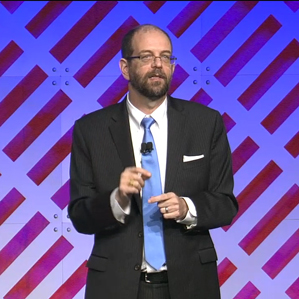Toyota Wants Its Cars to Expect the Unexpected
Toyota revealed more details of an ambitious plan to invest in artificial intelligence and robots today during a keynote speech by Gill Pratt, CEO of the new $1 billion Toyota Research Institute (TRI) at CES in Las Vegas.

Toyota will open two TRI facilities, near Stanford and MIT, and Pratt announced several high-profile new appointments and advisors. TRI will have a technical team consisting of several project managers formerly of the Defense Advanced Research Projects Agency and a number of professors working part-time, including James Kuffner, who previously led robotics research at Google. The advisory board will include luminaries such as the robotics pioneer Rodney Brooks and the NYU and Facebook AI researcher Yann LeCun.
Pratt also described two projects—one at Stanford, the other at MIT—that would feed into Toyota’s efforts to develop self-driving vehicles. These efforts could also produce fundamental and broad-reaching advances in artificial intelligence.
The Stanford project, entitled “Uncertainty on Uncertainty,” will focus on teaching cars how to deal with novel situations without specific programming. This could help in unpredictable situations that might result in traffic accidents, and it could ultimately help make automated cars a lot more practical (see “Driverless Cars Are Further Away Than You Think”). “It’s one thing to teach cars to respond to events you expect to occur,” Pratt said. “But the really challenging thing is, how do we teach the car to respond safely to events we do not expect, that we don’t anticipate.”
But the project is also relevant to an extremely important aspect of intelligence that no one has yet been able to replicate in a machine. Pratt said the Stanford team would focus on automating machine learning it ways to enable these capabilities.
The MIT project, called “The Car Can Explain,” will seek to devise ways for vehicles to account for their actions. This is something that could be important for automated driving, making it possible to identify logical problems that caused a car to behave incorrectly. But again, it is also an important aspect of human intelligence.
Toyota’s goal with TRI is to push its research beyond the automobile, and into home robots, or what Pratt described as “mobility inside.” The company aims to do this by researching and developing new hardware, software, and even materials.
While most car companies are investing in automated driving, Toyota has moved very boldly by hiring Pratt and establishing TRI.
Pratt was previously a program manager at DARPA, where he oversaw several major robotics competitions aimed at advancing the technology (see “Why Robots and Humans Struggled with DARPA’s Challenge” and “A Transformer Wins DARPA’s $2 Million Robotics Challenge”). Before DARPA he was an associate professor at MIT and a professor at Olin College of Engineering.
During his presentation, Pratt recalled Toyota’s origins as a company that made industrial looms before it entered the automobile market in 1933. He said that the company was contemplating a similarly seismic shift today, toward robots that might help care for the elderly and perform other tasks around homes.
“When we think about the love people have for their cars, it is possible home robots may become even more prized,” Pratt said. “It’s entirely possible that robots are going to become for today’s Toyota what the car industry was back when Toyota was making looms.”
Keep Reading
Most Popular
Large language models can do jaw-dropping things. But nobody knows exactly why.
And that's a problem. Figuring it out is one of the biggest scientific puzzles of our time and a crucial step towards controlling more powerful future models.
The problem with plug-in hybrids? Their drivers.
Plug-in hybrids are often sold as a transition to EVs, but new data from Europe shows we’re still underestimating the emissions they produce.
How scientists traced a mysterious covid case back to six toilets
When wastewater surveillance turns into a hunt for a single infected individual, the ethics get tricky.
Google DeepMind’s new generative model makes Super Mario–like games from scratch
Genie learns how to control games by watching hours and hours of video. It could help train next-gen robots too.
Stay connected
Get the latest updates from
MIT Technology Review
Discover special offers, top stories, upcoming events, and more.